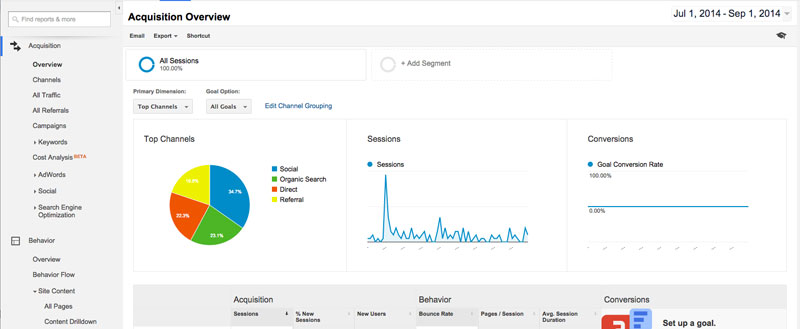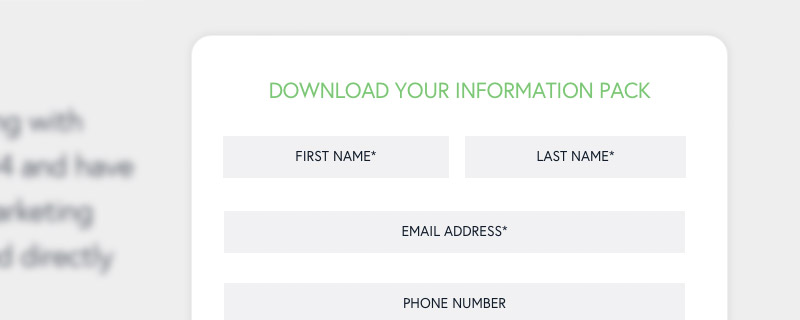BLOG
The 5 Signs that Your Property Projects Website Won’t Convert (And How To Fix Them)
Your property project website is one of your best tools for generating great leads, but if it is not converting visitors into customers, then something is wrong.
Need a hand? Below are five common signs that your property projects website won’t convert (as well as how to fix them).
1. No conversion tracking in Google Analytics

You are missing out on a golden opportunity if you are not using Google Analytics. This programme tracks users on your site and can show you bounce rates, exit rates and time spent on a single page. Having this data will help you see your website in terms of effectiveness.
Not sure how to set up conversion and web tracking through Google Analytics? Follow these five easy steps:
- Create a Google Analytics account and sign in. Go to the Admin tab and look in the ACCOUNT and PROPERTY columns. Choose which property you want to work with click on the Tracking Info > Tracking Code. You will need to put this code into every code page of your website.
- Locate the tracking code snippet. You will see it in a box with a few lines of JavaScript. The entire box is your tracking code, starting with <script> and ending with </script>.
- Copy the whole box. Do not leave anything out. If it helps, paste the script into a word document, just in case you end up copying something else.
- Paste this code into the code of every page you need to track. It should go just before the final closing tag (</head>).
- Go back to your setup to see that you have done this correctly. The tracking code now on your site should match what is shown in the code view.
2. Too much copy, not enough imagery
The balance between website copy and imagery is a fine scale to monitor. You need great copy to express a call-to-action (CTA) and to satisfy Google Panda’s need for original, meaningful copy, but too much copy will drown your viewers. On the other hand, what is a property website without images of properties?
So what is a good balance? Most experts recommend at least 300 to 500 words per page of your site. No matter what your topic is, this word limit will be more than enough to convey your message and create a great CTA. Be sure to disperse relevant keywords throughout the copy, but do so in a natural way. Readers will be able to tell when you are keyword stuffing, meaning forcing too many keywords into a paragraph which makes it awkwardly. So choose three or four relevant keywords per page.
When it comes to imagery, most property project websites tend to go one way or the other. Some have too many images; some have too few. Depending on what each page is devoted to, you may need more images than usual.
For pages that focus mainly on copy, keep the number of images equal to the hundreds of words you have on the page. If you have two hundred words, use two images. For pages in need of visuals, do not be afraid to show images. Create slideshows so the images do not take up the whole page.
3. Focused on flashy design instead of conversion
When someone logs onto your site, does one of the following happen:
- Background music begins to play
- The ‘enter here’ page appears and forces users to click through to the actual site
- Videos play automatically
- Scrolling pictures move rapidly
All of these website features will drive away visitors and halt any lead generation. Flashy designs have their place, but it is not on a property project website. The flashier the design is, the more likely it will distract readers from your content.
Flashy designs tend to make navigation confusing as well. If your navigation menu is more abstract than a Jackson Pollock painting, it is time to rethink how users are getting from Point A to Point B. It is best to keep all navigation simple and fluid. Label the tabs and make it extremely easy for visitors to go from the home page right to your content.
4. No retargeting
When a visitor comes to your website and leaves, it makes sense that you should go after them, right? This is what retargeting is all about. Rather than letting valuable customers get away and forget about you, you can retarget them and help them keep your company in the back of their minds.
There are a few ways you could go about doing this:
- Google Adwords: After a visitor leaves your site, Google Adwords will install an anonymous cookie onto their browser. Now whenever past visitors go to certain sites (these sites have contracts with Google), an ad for your property project website will appear.
- Perfect Audience: This retargeting effort focuses not only on the web, but also social media sites like Facebook and Twitter.
- Adroll: Similar to Perfect Audience, Adroll targets users on all different sites. It also follows users as they move from mobile device to browser.
5. No opt-in forms in exchange for info pack

In order to successfully build a contact list, you have to get site visitors to sign up for more information or create an offer to entice them to give you their contact information. You might try one of the following:
- Email list sign-ups: For visitors who like what they see and want more regular updates from you, these forms let them sign up, while giving you valuable information such as email addresses and other demographic information.
- Free ebook sign-ups: By offering free ebooks or other useful tools, visitors will feel less like they are giving away their valuable personal information for free.
- Invite to event or webinar: Are you planning to attend a local event or planning on hosting a webinar to discuss property buying tactics? Promoting these events help viewers connect your company to a face, your face to be exact, while you get email addresses and potential leads.
- Free trial: The best way to show off your product or service is to allow a short free trial period. Let your customers see how much easier their lives will be and convert them into long-term customers.
Any of these tactics will help you build a contact list and develop a list of strong leads. You can now focus your time and energy on pursing these leads.
By now, you should have a few ideas about how you can go about fixing your property project website. Try several of these ideas and track your websites progress through Google Analytics. When your website begins to convert more leads, you will be able to tell what is working and what it not.












